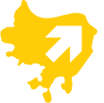(This article was written by Juergen Neumann in Sept. 2003. You can read the German original with pictures here. It was translated with the kind support of Magnus Lawrie)
Structurally weak regions in Europe still without broadband in the future.
Where there is no market there won’t be any broadband offered in the long term - unless people take their fate into their own hands. DjurslandS.net – an example from Denmark.
In many regions of Europe, the hope to get broadband internet will not be fulfilled. Neither the countries of The European Union nor the numerous internet service providers plan to cover structurally weak regions in the European Union with broadband internet within the next years.
Local authorities don’t have the money and internet service providers doubt the return on investment. As a consequence the digital divide within society – until now mainly associated with countries of the so-called third world – will affect many people in the heart of Europe in the coming years.
One of the most visible examples of this development was recently presented by a group of activists from Denmark at the freifunk.net summer convention 2003 in Berlin. Participants from Djursland (a rural region in Denmark - comparable with East Friesland, Germany) described in practical terms, how in their homeland - an area of 1491 square kilometers - no prospect whatsoever of access to the internet beyond an ISDN connection existed for many years.
“We have spoken to more than 35 internet providers,” Niels Chr. Sorensen reported “sadly without any success”. “Whoever moves to such a region, must accept limitations in the infrastructure”, said one internet provider. “The only point is,” Sorensen replied, “that most have lived here for generations”.
Digital Divide in the Centre of Europe
During the last years Djursland was increasingly affected by cuts in public spending. In 1998 the ferry port at Grenaa closed. In 2002 the region’s only hospital was shut. There are plans to close down the airport and onother ferry port. Since the year 2000 more than 82,000 people no longer have a daily newspaper.
However, people have not given up. With astonishing commitment they have started to take their fate in their own hands. “We do not want our children to miss out on connectivity, simply because they are growing up in a countryside region”, says Sorensen.
Building the Infrastructure in Djursland
As early as 2001 the Djurslanders began to provide broadband internet to the region on their own. By using WLAN they found an inexpensive and licence free way to do so. The community decided to rent the fibre optic backbone lying idle after the hospital closure in order to connect the 8 district towns of the region.
DIY Technology
Starting out from this fibre optic ring the respective districts are connected to the internet via WLAN with the help of more than 200 volunteers at cost price. To meet the high demand for coverage an extensive infrastructure was created.
Most recently, even antennas were manufactured, which are sold for 35 Euros. “Users have the choice of two preconfigured sets, which we – like IKEA – offer for self assembly”, says Sorensen.
Those connections linking the more remote settlements are mounted on existing buildings or if necessary, on individual masts. The required height is ascertained with helium balloons.
Next Step in Djursland
The concept is a complete success. By the end of 2003 about 3500 households singed up for the community network and 1000 were already connected. To use the 1-2 Mbits flat rate with no further limitations each household pays a one time set up fee of 270 Euros and a monthly fee of 13,50 Euros.
Certainly, it is not only about fast connectivity. “We not only seek for network administrators and technical support for our project. As important to us, is winning journalists, who will again provide news reports to our region”, believes Sorensen. Right now, it is namely the local aspect which makes the project so successful. Djursland also exemplifies that there are ways out of the growing divide in some of Germanys new federal states. Dark fiber is available in sufficient quantity all over the country.

